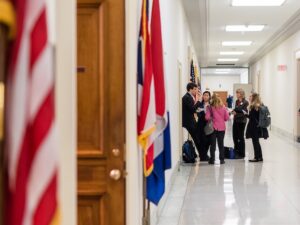Appropriations in action: CCLers rally to defend key climate and clean energy programs
By Elissa Tennant
Last month, CCLers mobilized en masse to contact their members of Congress ahead of the appropriations process. Together, we sent 12,859 emails to lawmakers encouraging them to fund key climate and clean energy programs.
Every year, Congress decides which programs and agencies to fund, and what level to fund them at. This is referred to as the appropriations process.
CCL hasn’t weighed in on this process before, but we felt this is an important avenue to urge Congress to reassert their authority. This action helped preserve our pathway to success, which we’ve identified is through work with Congress. Additionally, the Trump administration’s fiscal year 2026 (FY26) budget is seeking dramatic cuts to climate and clean energy programs, and we felt our voices could make a valuable impact.
The process is ongoing, but early signs from Congress are promising. On September 4, the House passed an energy and water appropriations bill. There’s no good way to sugarcoat it: This bill definitely included some harmful cuts to climate and clean energy programs, but the cuts are much less significant than those outlined in the President’s version of the budget.
During the debate on the bill, Republican members of Congress, including the chairman of the Energy and Water Development and Related Agencies Subcommittee, Rep. Chuck Fleischmann (R-TN), pushed back on completely gutting those programs. Publicly, he stated these programs are bipartisan and have his support.
Springing into action
Congress passes appropriations bills each year to fund government operations, usually by the September 30 deadline (the start of the federal fiscal year).
We told Congress to support robust funding for programs at NOAA, NASA, and the Department of Energy that will help preserve critical science and research, strengthen clean energy infrastructure, and ensure that America’s grid can meet rising demand.
We asked our representatives to reject proposed cuts to these agencies:
National Aeronautics and Space Administration (NASA)
NASA’s Earth-orbiting satellites and new technologies have helped scientists collect many different types of information about our planet and its climate. But the White House requested to slash NASA’s science funding by 47%.
National Oceanic and Atmospheric Administration (NOAA)
NOAA plays a critical role in weather forecasting, extreme weather warnings, and climate science. The agency’s research is also the gold standard for tracking the levels of carbon dioxide in the atmosphere and oceans, publishing that data publicly for America and the international community, and modeling/forecasting changes as a result. Yet the Trump administration’s proposed 2026 budget sought $2.2 billion cuts in NOAA research endeavors, grant programs and other initiatives, including dissolving the Office of Oceanic and Atmospheric Research.
Department of Energy (DOE)
The Department of Energy’s Office of Energy Efficiency and Renewable Energy (EERE) and Advanced Research Projects Agency (ARPA-E) are essential for energy innovation and reliability. EERE funds early-stage research and development activities to develop efficient energy and different types of energy sources, which is critical for America’s global energy leadership. Yet the White House had proposed cutting this office’s budget by 74%.
ARPA-E develops cutting edge energy technologies that keep us ahead of global competitors while driving down costs. It’s extremely bipartisan and well-supported in Congress; yet the White House’s budget proposes a 57% cut to this agency.
We lobbied on this, too!
If this all sounds familiar to you, it’s because we lobbied on this issue in July, too! During our 402 meetings on Capitol Hill, we asked Congress to support the clean energy transition for affordable and reliable power as well as a safer climate.
As a tactic to achieve this ask, we requested Congress support targeted programs that enable clean energy to compete, scale, and deliver dependable and affordable power to Americans. Specifically, we mentioned the DOE programs EERE and ARPA-A as two key programs to lower energy costs through innovation and clean energy investment.
Our mobilization built on this ask by generating 12,859 messages to Congress between August 13 and September 6.
The results so far
The appropriations process is a long one, but it’s a key focus for Congress right now. Appropriations are mostly negotiated behind the scenes, but we’re starting to see some results. The House passed its energy and water appropriations bill early in September, which significantly reduced cuts to Department of Energy programs we lobbied and mobilized around protecting. During the debate, Republican members of the committee, including the committee chair, Rep. Chuck Fleischmann (R-TN) pushed back on additional major cuts to the DOE programs.
While this specific bill will not necessarily be what’s ultimately signed into law (the Senate and House still have to negotiate and agree), we’ve already made a difference. Thanks to everyone who sent one of our 12,859 contacts to Congress. Remember, it’s timely actions like these that create a major impact in our country’s climate policies.
Keep the momentum going! Get loud for the climate and encourage others to do the same. View our latest actions here.






